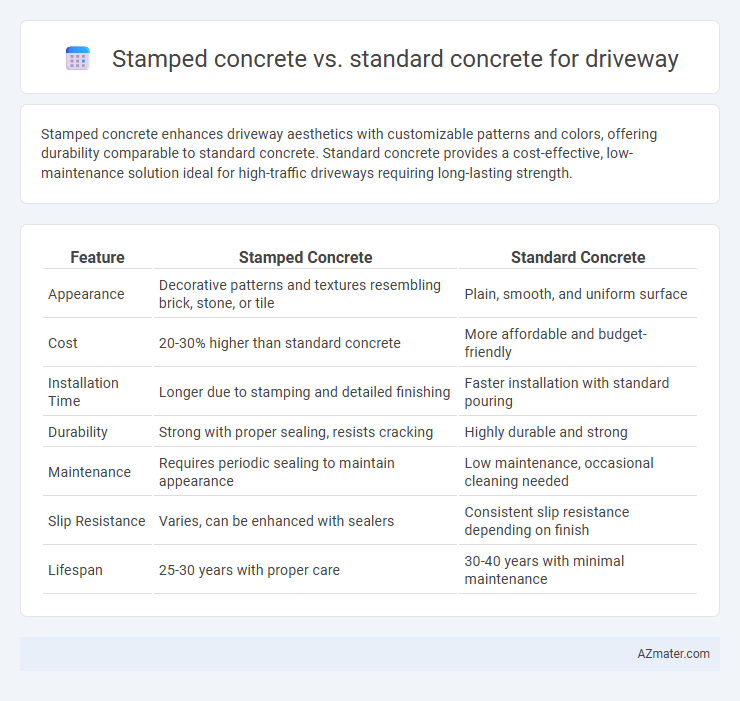Stamped concrete enhances driveway aesthetics with customizable patterns and colors, offering durability comparable to standard concrete. Standard concrete provides a cost-effective, low-maintenance solution ideal for high-traffic driveways requiring long-lasting strength.
Table of Comparison
| Feature | Stamped Concrete | Standard Concrete |
|---|---|---|
| Appearance | Decorative patterns and textures resembling brick, stone, or tile | Plain, smooth, and uniform surface |
| Cost | 20-30% higher than standard concrete | More affordable and budget-friendly |
| Installation Time | Longer due to stamping and detailed finishing | Faster installation with standard pouring |
| Durability | Strong with proper sealing, resists cracking | Highly durable and strong |
| Maintenance | Requires periodic sealing to maintain appearance | Low maintenance, occasional cleaning needed |
| Slip Resistance | Varies, can be enhanced with sealers | Consistent slip resistance depending on finish |
| Lifespan | 25-30 years with proper care | 30-40 years with minimal maintenance |
Introduction to Driveway Concrete Options
Stamped concrete offers decorative patterns and textures that mimic stone, brick, or tile, enhancing driveway aesthetics while maintaining durability. Standard concrete provides a cost-effective, strong, and low-maintenance surface ideal for long-lasting driveways. Choosing between stamped and standard concrete depends on budget, design preference, and desired driveway functionality.
What is Stamped Concrete?
Stamped concrete is a decorative concrete surface that imitates the appearance of natural materials such as stone, brick, or slate by pressing patterned molds onto freshly poured concrete. It offers enhanced aesthetic appeal and increased durability compared to standard concrete, making it a popular choice for driveways seeking both functionality and visual impact. The process includes the application of color hardeners and sealers, providing long-lasting protection against wear, stains, and weather elements.
What is Standard Concrete?
Standard concrete is a mixture of cement, water, sand, and coarse aggregates that hardens into a durable and strong surface commonly used for driveways. It provides a smooth, uniform finish but lacks decorative patterns or textures found in stamped concrete. Standard concrete is favored for its cost-effectiveness and straightforward installation, making it a practical choice for functional driveway surfaces.
Aesthetic Differences: Stamped vs Standard
Stamped concrete offers enhanced aesthetic appeal for driveways by replicating the look of natural materials like stone, brick, or wood, providing texture and intricate patterns that standard concrete lacks. Standard concrete, typically smooth and plain, offers a utilitarian and minimalist appearance without decorative elements. The visual versatility of stamped concrete makes it a preferred choice for homeowners seeking a customized, elegant driveway finish.
Durability and Longevity Comparison
Stamped concrete offers enhanced durability compared to standard concrete due to its thicker surface layer and the use of integral color and sealing agents that protect against cracking, scaling, and weather-induced wear. Standard concrete, while strong and capable of supporting heavy loads, often requires resurfacing or sealing to maintain longevity when exposed to freeze-thaw cycles and harsh elements. In terms of lifespan, stamped concrete driveways typically last 25 to 30 years with proper maintenance, whereas standard concrete can last around 20 to 25 years but may show signs of deterioration sooner without protective treatments.
Cost Analysis: Stamped vs Standard Concrete
Stamped concrete for driveways typically costs between $8 and $18 per square foot, reflecting expenses for patterning, coloring, and finishing techniques; standard concrete ranges from $4 to $10 per square foot, making it a more budget-friendly option. Installation cost factors include labor intensity and material volume, with stamped concrete requiring skilled artisans and additional curing time, increasing overall expenses. Maintenance costs also differ, as stamped concrete may require periodic resealing to retain appearance, while standard concrete demands fewer upkeep measures, influencing long-term investment decisions.
Maintenance Requirements for Each Type
Stamped concrete driveways require regular sealing every 2 to 3 years to preserve color and prevent cracking, whereas standard concrete generally needs minimal sealing and occasional cleaning. Stamped concrete is more susceptible to surface wear and fading from UV exposure, demanding more frequent maintenance to maintain appearance. Standard concrete's durability allows for easier repair of cracks and stains, resulting in lower overall upkeep costs over time.
Installation Process: What to Expect
Stamped concrete installation for driveways involves pouring a standard concrete slab followed by imprinting patterns and textures using specialized molds before the concrete fully sets, requiring skilled labor and precise timing. Standard concrete driveways focus primarily on pouring and smoothing the concrete surface, resulting in a quicker and less complex installation process. Both methods require proper curing time, but stamped concrete demands extra attention to sealant application for durability and aesthetic preservation.
Pros and Cons Overview
Stamped concrete offers aesthetic versatility with patterns and colors that mimic natural stone, enhancing driveway curb appeal, but it can be more expensive and prone to cracking over time. Standard concrete provides a durable, low-maintenance, and cost-effective option, suitable for heavy traffic and long-lasting performance, though it lacks decorative appeal. Maintenance for stamped concrete includes resealing to preserve its look, while standard concrete requires minimal upkeep but may not enhance property value as significantly.
Choosing the Right Concrete for Your Driveway
Choosing the right concrete for your driveway involves weighing the durability and aesthetic appeal of stamped concrete against the cost-effectiveness and simplicity of standard concrete. Stamped concrete provides decorative patterns and textures that mimic natural stone, increasing curb appeal and property value, while standard concrete offers a sturdy, low-maintenance surface ideal for heavy traffic and long-term use. Consider factors like budget, design preference, climate resilience, and maintenance requirements to determine whether the enhanced style of stamped concrete or the practicality of standard concrete best suits your driveway needs.

Infographic: Stamped concrete vs Standard concrete for Driveway
 azmater.com
azmater.com